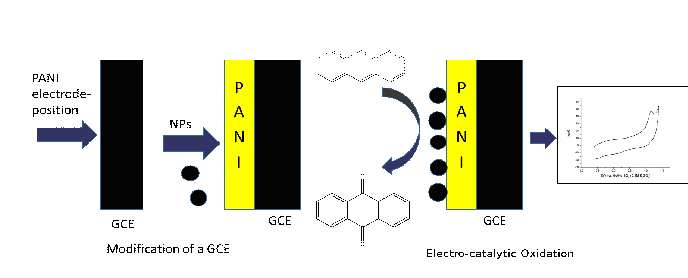Noble Metals NPs-Conducting Polymer Nanocomposite Modified Electrode for Detection of PAHs
Polycyclic aromatic hydrocarbons (PAHs) which are by-products of incomplete combustion of organic materials, have been listed as priority substances for monitoring by several environmental agencies.[1] This is because of their occurrence in the environment and the adverse health effects they can have mainly being carcinogenic. The conventional methods that are used in the analysis of PAHs include gas chromatography and high performance liquid chromatography, which are very laborious and require specialized training and equipment which tends to be expensive. Electrochemical detection has been proposed and explored as a possible alternative because of the simplicity in operation and speed of analysis. However, it often suffers from low sensitivity. The efforts towards a sensitive electrochemical detection method have included modifying a working electrode with metal oxide nanoparticles (NPs), noble metal NPs (Ag, Au etc.), graphene, and a conducting polymer (PANI, Nafion, polypyrrole etc.) to improve electro-catalytic oxidation of a PAH on the electrode surface.[2-4] Such strategies have recorded enhanced sensitivities to a certain measure. Nevertheless, since the Maximum Allowable Concentrations cited by directives from environmental agencies are very low, further effort towards a more sensitive platform is justified.[1]
The present research is geared towards the same end using single metal and alloy NPs with a conducting polymer hoping for synergy in the electro-catalytic oxidation of PAHs. Some of the reducing and capping agents used in the synthesis of NPs are hazardous and pose a threat to the environment and the chemical worker. Therefore, in this work the NPs are synthesized using a plant extract which offers a safe and sustainable method.

REFERENCES:
1. Directive 2013/39/EU about priority substances in water policy
2. Fayemi et al. (2016). Journal of Nanomaterials (2016): 1-12
3. Mailu et al. (2010). Sensors 10, 9449-9465
4. Tovide et al. (2014). Sensors and Actuators B 205, 184-192
This research is generously supported by a grant from Deutscher Akademischer Austauschdienst DAAD administered by Technische Universität Chemnitz